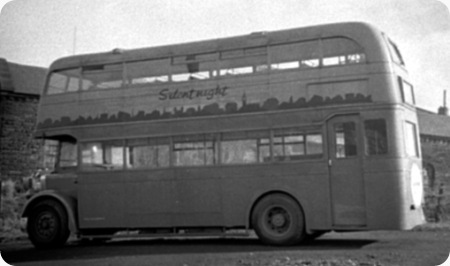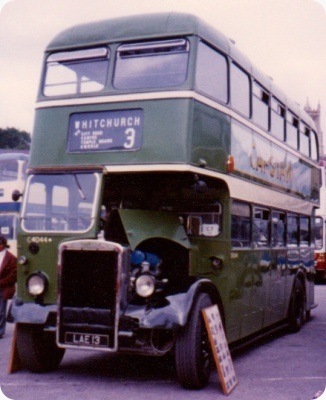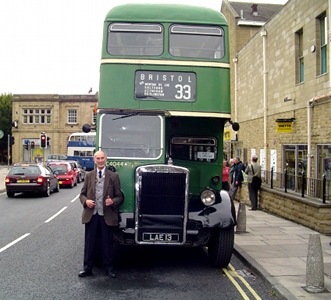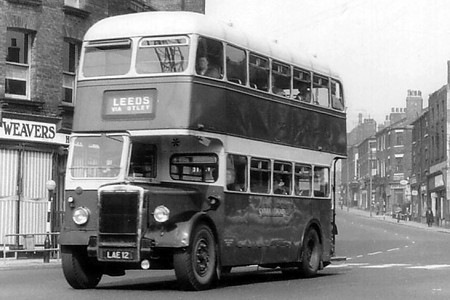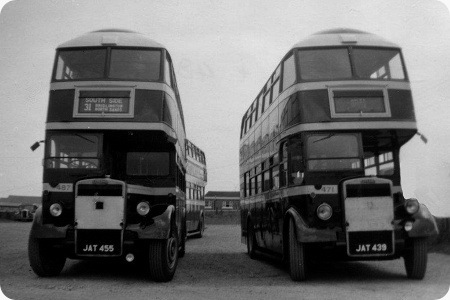
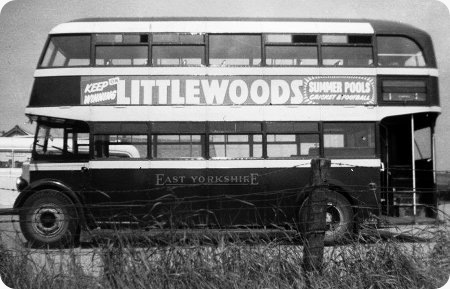
Copyright both shots Bob Gell
East Yorkshire Motor Services
1949
Leyland PD1
Roe H?R
Seen on 25 June 1958 at the North Landing terminus of route 31 from Bridlington are
these classic members of the East Yorkshire fleet.
At that time, I remember them as regular
performers both on the North Landing service and the then separate service to the Lighthouse.
As a
visitor from Nottingham, holidaying at Flamborough, I was intrigued by the destination screen
arrangement, with what looks like an additional foothold in the middle of the radiator, together with
the grab handle to the bottom left of the blind box, to help the conductor reach the board to flip it
over. On the nearside shot, the additional foothold and grab handle can also be seen. Quite
precarious! What a pity one of this class was never preserved.
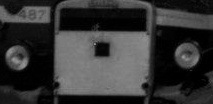

The other unusual aspect to me of East Yorkshire, apart of course from the Beverley Bar roof, was
the Willebrew ticket system, the like of which I had never seen before. It all added to the impression
of being on holiday in a different world and certainly left a lasting impression.
Other vehicles
in the above shots are top right JAT 439 - 471 and the side view is of JRH 991 - 518 both PD1s
Photographs and Copy contributed by Bob Gell
A full list of Titan codes can be seen here.
Interesting vehicles with a system the ‘elf & safety’ folk would have a heart
attack over nowadays!
Was the dome-like roof replicated inside as well, or was that flat?
Chris Hebbron
Only the heads of those who didn’t duck!
David Oldfield
Not sure about the foot hole in the middle of the radiator, I would of thought
that could get quite hot after a run from Hull to Scarborough or did EYMS supply asbestos lined
shoes to their conductors
Trevor
These were among the most beautiful and characterful vehicles of their time,
and rank very highly on my personal list of favourites. The interior upper saloon contour was
identical to the "Beverley Bar" exterior. The Health and Safety comments are valid of
course, but pale into insignificance in comparison with the metal "bible" displays common
amongst the Tilling Group operators before the War, where the driver or conductor had to climb onto
a slippery metal step while hoisting the entire heavy metal assembly up aloft !! These beloved East
Yorkshire vehicles had another unusual feature within - the lovely Roe wooden window frames were not
stained and varnished, as was the norm elsewhere, but were painted a pleasing mid blue in durable
gloss. On the rear platform wall near the stairs was another delightful anomaly presumably caused by
a temporary shortage of transfers. A warning notice, about a foot square, in gold leaf warned
alighting passengers to :-
WAIT
until the bus
STOPS
On quite a few vehicles this read "Wait until the COACH stops" - a
kind of unintentional "tongue in cheek" accolade to the superior quality of these fine
machines perhaps ??
Chris Youhill
Barton Transport of Nottingham acquired one of these, JAT 410, in the late
1950s or early 1960s. I think it was Barton running number 951. This may seem a very high number for
a 1946 vehicle, but Bartons always numbered their vehicles strictly according to the date of
acquisition, with no attempt to allocate batches of numbers to particular types. Hence the famous
1948 front entrance lowbridge Duple PD1s were in the 400 and 500 series. When they later acquired
some ex-LT RTLs they were in the 1000 series.
Stephen Ford
Wonderful, evocative photographs! As a kid, whenever we went into York City
centre, I would be looking out hoping to see one of these great vehicles on the 44/45/46 routes
between Leeds and Bridlington or Hull - a rare treat, unfortunately, because it was a joint service
with West Yorkshire, and usually the EYMS buses were single-deckers any way. Once we managed to
travel on one on a trip to Bridlington but my dad insisted on sitting downstairs, so I never got to
see the interior of a Beverly Bar roof.
Their magnificent indigo and primrose livery was
complimented by the lovely Leyland engine silky tickover. They had beautiful blue upholstery and
cream stanchions which gave them an extra air of superiority. We’d got to Rougier Street to catch
the Bridlington bus on a typically raucous York-West Yorkshire Bristol K5G still sporting a
‘bible’ metal indicator, (called a ‘flap board’ at York, and thanks, Chris for reminding
me of them), so the comparison between the two vehicles was pretty one-sided.
As Bob points
out, another novelty was getting a Willebrew ticket; operationally, the system itself was cumbersome
and laborious, but the tickets were fascinating for a young child to examine.
Roy Burke
Unlike Roy I have managed a ride on the preserved Roe bodied AEC Regent V
WAT652 The overall effect was of entering a gothic church with a definite arching to the roof line I
have also had a ride on East Yorkshire’s own Willowbrook bodied AEC where the interior roof line was
not so pronounced However both buses were different to the norm. As well as the Beverly Bar roofed
fleet EYMS also ran a fleet of standard lowbridge buses which ran in Hull and were not allowed under
the Bar.
Chris Hough
I too remember the EYMS PD1s with great affection. The memory is made more
vivid by Chris`s description of the mid blue painted internal window framing. I remember them so
well as fast, smooth buses, which prompted me in previous posts to quote them in the "rough PD1
discussions" of a week or so ago!
My main experience of them was on the Bridlington to
Hornsea service, via Barmston, Beeford and Atwick, when we had our Skipsea "Bradford Tram"
bungalow.
It was after one of these visits to Skipsea, about 1950, when we were returning from
Brid. on the Leeds service. Memory of the Brid to Leeds section has eroded away, but the York
(Rougier Street) to Leeds section is so vivid! The (West Yorkshire RCC) bus failed, and we were
transferred to a highbridge York West Yorkshire Bristol GO5G!
I can still hear every grunt of
the gearbox, and every growl of the 5LW as we (slowly) made our way through Tadcaster, and back to
Leeds Wellington Street. Just one of those indelible memories as a youngster, which cemented my
transport interests, and firmed up for ever my love of Bristol buses of that era!
John Whitaker
I’ve always been puzzled about the Beverley Bar roof. The inward taper to the
upperworks I can understand, to enable the windows and sides of the roof to clear the sides of the
arch, but why was it necessary to extend the roof upwards as well? And on these PD1s there is no
discernable taper to the windows at all, just a domed roof.
Peter Williamson
Gosh, John, York to Leeds in a Y-WY GO5G! No wonder you remember that; 1935 or
1937 vintage, complete with a ‘flap board’ indicator, and, in around 1950, close to its
withdrawal date.
WY and Y-WY had a ‘contra-mileage’ arrangement under which, at weekends
mainly, WY would use Y-WY vehicles to balance the mileage that WY vehicles had operated during the
week on such things as school or works specials. I have a photo of a Y-WY K5G, (highbridge of
course) used on service 43 to Scarborough; if you found the going to Leeds slow, imagine how a
fully-loaded 5LW-engined double-decker coped with Whitwell. Incidentally, as a conductor with Y-WY
in 1962 or 1963, I was once asked to stay on after finishing my shift to operate a late bus to Hull
because the East Yorkshire vehicle, (I think they were then using AEC Bridgemasters), had broken
down in Leeds. As it happens, they got it running again, so I didn’t get my overtime.
Roy Burke
Some optical illusions here Peter which can I hope be briefly explained. The
reason why there was no "inward taper" on the PD1 windows is that the vehicles were only
7’6" wide - I think the angle in the windows became necessary with 8’0" buses later. Also
I’m sure that the upper edges of the windows were only at the height normally found in
"lowbridge" buses, and accordingly the roof was not actually extended upwards but was
merely at standard "highbridge" level for passenger headroom purposes. This is a most
fascinating discussion, and I’d love to have been a fly on the wall when EYMS initially approached
bodybuilders with these special requirements - I daresay calendars were hastily scanned to ensure
that it wasn’t April 1st !!
Chris Youhill
Yes Roy, the memory of the "G" highbridge ride is really
vivid… it was one of the YG batch. I have to admit being a real West Yorkshire fan of those
days, much as I also loved East Yorkshire, because the latter were different. Tilling fascination is
something else!
Another vivid memory of the Leeds to Bridlington route was the regular use of
pre war L types, and the notice on Garrowby Hill "West Yorkshire Road Car Co" DRIVERS ARE
INSTRUCTED TO ENGAGE LOW GEAR. Or was it "Requested"?
I tended to lose interest in
West Yorkshire after the 1954 renumbering, it being the pre 1950 types which I loved most, and it
seems just like yesterday that I rode on Gs on the Thornton Road routes in Bradford, to Denholm and
Keighley, where they competed with our beloved BCPT trolleybuses!
Memories of conductors
licking their indelible pencils, stacks of bible boards in the green hut in Chester Street, and the
requests for "smokers to occupy rear seats", and "Please tender exact fare and state
destination". The most evocative sound of all, the guttural growl of a 5LW just starting up,
the inability for a clean gear change (always a grinding sound!) and drivers with their cotton
summer dust coats.
Wonderful memories!
John Whitaker
Yes John, I well remember the transfers in the prewar vehicles. I recall that
the smoking one was on four lines thus :-
SMOKERS
ARE REQUESTED
TO OCCUPY
REAR SEATS
Another fabulous transfer used to fascinate me too - it was a transparent one,
small and rectangular, which was applied to the insides of the windows and read :-
WILFUL DAMAGE TO SEATS, FITTINGS ETC
The Company will press for
heaviest
penalties against offenders
Chris Youhill
I DO remember the "wilful damage" transfers!! How evocative is
that??!! Also the moquette covered box adjacent to the single seat over the wheel arch on the Js and
pre-war Ls! Super comments too from you and Richard about the post war Ls. I remember being
overwhelmed (like you) by the sheer modernity of the clean lines of post war ECW bodies when they
first appeared, contrasting so strongly with the pre war "roundness". Pre war ECW and Roe
bodies were almost "Beverley Bar" with their domed roofs in highbridge form. Perhaps we
should transfer this topic away from EYMS into a more WYRCC subject heading!
John Whitaker
I apologise if some of us are turning this lovely posting about EYMS PD1s into
a discussion on West Yorkshire instead, However, recalling John’s and Chris’s comments on notices, I
rather think the wording on the notice at Garrowby Hill was ‘instructed’. The ‘smoking’
notice I particularly remember on WY’s JO5Gs, but didn’t they also have a small plastic label on the
backs of the front rows of seats with the same request instead of an ashtray?
I was intrigued
by John’s recollection that the GO5G he rode on to Leeds was a YG series; my own fleet list mentions
1935 AWW vehicles, (Y316-330) and 1937 BWT vehicles, (Y343-346), but the only record I have of Y-WY
YG-registered vehicles, (apart from some Dennis Lancets), is of 3 lowbridge GO5Gs that were bought
new from WY but sold back after only about seven months in 1935. Well, I’ve been wrong before!
Like you, John, I find the sound of a 5LW most evocative. Y-WY certainly got its money’s worth
out of them. Some of the 1939 batch of K5Gs, (admittedly they were rebuilt and re-registered), were
still in service very nearly 30 years later.
Roy Burke
The latter one, I think was a Tilling or THC notice as I don’t recall seeing
it on BET group vehicles. Midland General had it on all their vehicles and on double deckers also
had:
IN THE INTEREST OF OTHER PASSENGERS, WORKMEN ARE RESPECTFULLY REQUESTED TO TRAVEL IN THE
UPPER SALOON
Presumably this was because the lower saloon seats were moquette whilst the upper
deck seats were leather and easier to wipe clean after dirty workmen! In mining areas it was common
for pitmen to travel to and from work in their ‘grime’ as many mines did not have pit-head
baths until after they were nationalised.
Another notice I remember was:
SPITTING
STRICTLY PROHIBITED which seems inconceivable nowadays but was also aimed at miners, many of whom
used to chew tobacco rather than smoking it!
Chris Barker
31/01/11
Hi Roy Sorry about the YG/AWW. My mistake…I was dreaming about the main
fleet G05Gs based at Bradford, which carried YG registrations.!!
Old age creeping in!
John Whitaker
31/01/11
"No Spitting" was not just aimed at miners, and not at their tobacco
which was only a substitute for woodies down the pit. Firstly, they and anyone living in the
industrial atmosphere were prone to chronic respiratory problems which often meant the need to clear
the airways: then it was felt that such clearance- by anyone- could spread TB. Those who remember
those days find today’s macho spitting a bit disturbing.
Because of their numbers and shift
patterns, miners often had "special" buses, another interesting source of vintage
transport.
Joe
31/01/11 - 15:07
Regarding the prohibition of spitting This brings to mind the verse by I think
Spike Milligan There was a man from Dargeeling who took a bus to Ealing
It said by the door do
not spit on the floor
So he carefully spat on the ceiling!
Chris Hough
31/01/11 - 20:19
With regard to "No Spitting", as I recall, Hull Corporation buses
carried the notice "Do Not Spit - Penalty £5". I wonder how many £5’s were collected?
Keith Easton
01/02/11 - 05:10
You’ve beaten me to it Chris with your response to Peter’s Gothic roof
question! You are absolutely correct about the buses being to standard highbridge height and layout,
but with the upper deck windows set lower - in effect in the lowbridge position. Also the panel work
between decks is of shallower, lowbridge proportions. Construction & Use Regulations stipulated a
minimum gangway height for each deck, so the central gangway upstairs would have had to comply with
this just as on any other double-decker, whether highbridge, lowbridge, Lodekka et al. Although the
low set windows must have had an impact on the view from the top deck, it would have been a much
easier solution for the coachbuilder, rather than setting the windows in their normal highbridge
position and then trying to mould the glass into that classic Gothic shape! As Roy says, very
evocative pictures indeed. As youngsters, my brothers and I often visited Bridlington and
Flamborough in the family Morris Minor. If we were lucky we would catch sight of a pointy-roofed bus
or two around Driffield, which meant that the sea wasn’t too far away. Our favourites were the
PD2/Roe ‘LAT’ registered batch - some of which crooned their way around Brid bound for the
exotic-sounding ‘Belvedere’. Roe bodies of that era were always beautifully proportioned, but
I must admit to feeling that the extra width of the eight-footers somehow added a fullness to the
design. The Beverley Bar roof was just the icing on the cake.
Brendan Smith
01/02/11 - 05:13
I don’t think £5 for spitting was very good value for money. If I had had
money to waste in those days (and I must say that I never did!) I would have pulled the
communication cord and stopped an express : "Penalty for improper use £5"!
Stephen Ford
01/02/11 - 15:21
Well said Stephen - I always admire a man prepared to haggle honourably for a
genuine bargain !!
Chris Youhill
02/02/11 - 06:29
I can recall seeing signs that said, "Penalty for spitting - 40/-"
which is strange wording; nobody ever sold me anything saying, "That’ll be 40 shillings
please".
Maybe the folk who lived locally were poorer than those living in the £5 ones!
Chris Hebbron
02/02/11 - 10:00
Oh dear, this is getting silly! However, as we seem to be scraping the bottom
of the barrel somewhat, might I ask others for an explanation of the old notice in BR train toilets:
‘Gentlemen Lift The Seat’. Was this a request or a definition of a gentleman?
Roy Burke
02/02/11 - 20:57
The first sentence I ever read was "MIND YOUR HEAD", found in all
Reading d/ds until the Crossleys arrived with their stodgy "Caution: low roof", but the
one that tickled me most was "Do not speak to the man at the wheel whilst car is in
motion", seen in the normal-control front-entrance Guy B & BA single-deckers of 1926-30. Two of
them had their 4-cylinder petrol engines replaced by AEC 4-cylinder oilers, with oversized-looking
AEC radiators to match. The last were withdrawn in 1947. "Spitting prohibited" and
"Please retain ticket for fare paid" afforded more reading practice.
Ian Thompson
03/02/11 - 20:10
The remark about "Gentlemen lift the seat" reminded me of a public
convenience in my home area which had the sign "Gentlemen adjust your dress" - possibly
leading to confusion as to which door one had entered or what one should be wearing. When this
convenience was demolished a few years ago, the back wall adjoining another building was left
intact, complete with this sign on the white tiling for all to see! (The "equipment" had
been removed).
And to bring this back to what this site is all about, this facility was
adjacent to the White House pub, Milton in Portsmouth, which was a significant timing point and a
short-turn destination for some routes. In the final trolleybus days, the BUT’s would run on the 5/6
from Dockyard through to Cosham Red Lion. But those lovely "Leylandised Crossleys" (ie the
Crossley bodied DD42/7s with Leyland TD4 engines) would run short workings from the Dockyard and
turn at Milton White House. The full route also passed the Green Lane terminus of other t/b routes
(7/8, 11/12), so there were some colourful destinations (Red Lion, Green Lane, White House).
And why ever did Portsmouth change the Dockyard destination to "The Hard
Interchange"? OK, I know the street is called "The Hard", and the interchange was for
buses, trains and ferries, but who wants to undertake a "hard interchange" - perhaps it
was difficult after all. Anyway, these days it’s called "Gunwharf Quays" but the buses are
still in more or less the same place. Pity there are no Crossleys though.
Portsmouth also had
"spitting prohibited" on both decks of older vehicles, blue-edged gold lettering, with the
additional wording "no smoking" on the lower deck.
Michael Hampton
03/02/11 - 20:42
With regard to destination indicators, I’m reliably informed that Maidstone
trolleybuses carried the destination "Loose Womens’s Institute"! The terminus was situated
in the area of Maidstone known as Loose.
Keith Easton
04/02/11 - 06:55
I think there is probably scope for an article on unusual, eccentric or
amusing destination displays. Was Westward Ho! (Southern National) the only one that included an
exclamation mark?
Stephen Ford
07/02/11 - 05:33
I have been researching this fleet, largely because I have loads of nostalgia
for EYMS in the period 1946-1963. I have used the excellent East Yorkshire site fleet list, to gain
a list for this period, but would love to know which of the TD4/5s were rebodied post war, with ECW
Beverley Bar type bodies. Most grateful, if anyone can answer, and thanks in anticipation.
John Whitaker
07/02/11 - 05:43
I have managed to find a few prints of 1960s photos taken with a plastic
Brownie camera.
The location is Limekiln Lane which was the terminus for the EYMS Bridlington
Route from Belvedere South Side Terminus to the North Sands (ie Limekiln lane- which was close to a
Caravan site.
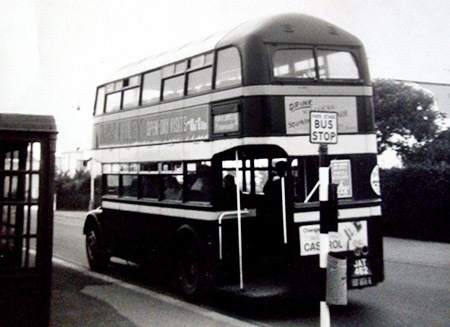
I took the above rear view shot in spring 1964 of
JAT 462 fleet no 494 for the roof profile as so few of this view existed, it was a 1950 Leyland
Titan PD1A H28/26R. I had heard that these Leylands were due to be disposed of within a short time
so recorded them in Bridlington not far from my home - note the East Yorkshire Bus Stop sign and old
cast iron bus shelter - boy did you need a shelter near the cliff top.
Ian Gibbs
07/02/11 - 09:05
After a quick look John I’ve found that the ECW rebodying of the TD4s/TD5s
took place in 1948, creating some of the most fascinating vehicles ever.
Those involved were
:-
358/365/366/368/372/374/375/376/377/378/380/381/382/383/384.
When I was in the RAF at
Patrington in 1955/6 we used to go into Hull on Friday and Saturday nights and a duplicate was
always provided on the last bus to Withernsea - it was invariably one of the rebodies to my delight.
A most fascinating performance occurred on this journey. As each village was reached, and many
people alighted, a rapid census of both buses would be carried out and as soon as the total could be
accommodated on one vehicle a reshuffle was ordered, almost invariably at Keyingham, and the
rebodied TD would return empty to its stable at 252 Anlaby Road while the service bus scurried
eastwards to Withernsea Depot.
Oh to go back to those happy days !!
Chris Youhill
07/02/11 - 09:07

Ian, a lovely classic picture at Limekiln Lane - and I’d completely forgotten,
or perhaps never noticed, that the stop plate is marked "FARE STAGE"
Chris Youhill
07/02/11 - 20:07
Thanks Chris for the ECW rebody detail of EYMS TD4/5s.
I remember them
so well, and the super sedate smooth sound as they meandered from Ulrome to Bridlington. They were
not the regulars on this route in my time, but they did come to Brid, I think direct from Hull via
Skirlaugh, Leven and Beeford.
I presume that other TD4s gave up their units for the Beadle
rebuild coaches.
What surprises me a bit is that more of the ECW Titans succumbed to rebodying
than did the Brush variety. Perhaps ECW built to a price for the (unusual) double deck Federation
style. My childhood trademarks for EYMS were dds with 3 windows up front on the top deck, and sds
with oval rear windows!
John Whitaker
07/02/11 - 21:34
Further to the EYMS TD5 rebodies, which Chris remembers so well from the
passenger shuffling occurrences (!) can anyone recall any other highbridge ECW rebodying of Titans
in the TD3-7 range? There must have been a BET contract, as Ribble, East Kent and others received
lowbridge bodies on TD4/5 chassis.
I presume that all East Yorkshire`s Arab 1 and 11s were
rebodied, all by Roe.
The photo of the PD1A at Limekiln Lane is very evocative. Is it not on
the old White Bus route out of town? I remember well going past the caravan park on White Bus
Bedford OWBs, and we had a holiday there in 1964, probably just at the same time as the photo of the
PD1A was taken. I am getting to like East Yorkshire more and more!
John Whitaker
08/02/11 - 05:20
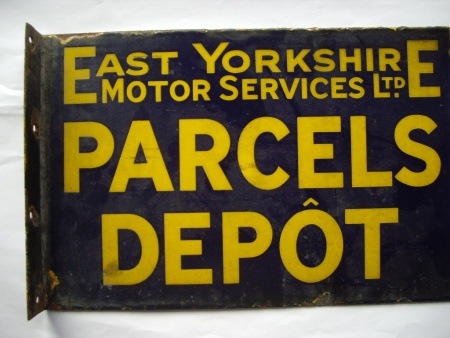
Following Chris Youhill’s interest in that EYMS -Bus Stop -Fare Stage sign.
Here is a picture of an interesting relic from the Golden Days of Bus Services
Ian Gibbs
08/02/11 - 05:25
I Believe that both White Bus and Eat Yorkshire operated services via Limekiln
Lane to Flamborough. The acquired routes were soon assimilated to EYMS licences BE3/39 and BE3/40.
By the way, John, East Yorkshire is fantastic. I have a full fleet list if you would like one. You
can contact me via the website.
Keith Easton
08/02/11 - 05:27
I have always been fascinated by this bus. I am getting married this year and
would love to use this bus. My brother is coming over from America and my Dad has always has old
cars and buses. So I would like to have this bus on my wedding day and surprise them all. If you
could let me know where I can talk to someone about this I would be so grateful saw this bus at
Pocklington Thoroughbred Car Club rally this year. Thank you so much.
Carol Eveson
08/02/11 - 05:29
Me too John, for it’s fascinating history and the fact that it’s still very
much in business today but I do worry about what will happen to it when Peter Shipp decides to
retire!
Chris Barker
08/02/11 - 09:01
Hello Keith.
Yes, I would love a full EYMS fleet list, as it would save
me going through each individual number on the website fleet list. I only need to go as far as 1963
though, if that makes it easier.
Many thanks
John Whitaker
Keith if you mail it to me I will pass it on I have a feeling that other
people may be interested, I am for one.
Peter
10/04/11 - 05:00
Reading these East Yorkshire postings relating to the Leyland PD1’s has
brought back some wonderful memories of holidays at the seaside in the 1950’s and early 60’s, when
these buses were a constant source of fascination to me as they ambled around Bridlington; I seem to
recall them showing ‘Old Town’ as one particular destination on the blinds, which was presumably the
area around the harbour?
Brendan Smith’s recollection of looking out for the sight of a
‘pointy-roofed bus’ around Driffield, and thus knowing the sea wasn’t that far away, was
particularly poignant. We used to invariably stop at a café near Driffield on our way to the coast,
I think it might have been called ‘The Four Winds’, and sitting there drinking tea, with one eye on
the bucket and spade and desperate for the sight of an East Yorkshire ‘decker, is a very strong
childhood memory. I have a feeling that the prominent windsock at the airfield, which was visible
from the café windows, might well have been responsible for the name of the cafe!
Likewise Ian
Gibbs’ classic rear end shot of 494 at Limekiln Lane is very evocative of caravan holidays at
Bridlington back in that era. My father once left the family camera, an old Agfa, on an upstairs
seat at the terminus at this spot, and the bus had headed back into Bridlington before he’d realised
his mistake. Sure enough, he found it lying right where he’d left it some time later after the
vehicle had completed the round trip and arrived back at Limekiln Lane again.
Those
full-fronted PD2’s in the yellow and light blue livery running between Hull and Scarborough were
something to behold as well, the ‘Beverley Bar’ roof looked even more striking on these vehicles, I
thought. The sight of these remarkable machines trundling along the main road past the Butlins
holiday camp at Filey, with all its flags flapping in the breeze, is an abiding holiday memory that
will be with me forever.
Dave Careless
19/04/11 - 09:00
Thanks Dave for even more fascinating memories of a wonderful era in the
greater Bridlington era. Two of your points are of particular interest. Firstly "Old Town"
was actually nothing to do with the resort or the harbour - it referred, and still does, to the
ancient settlement of "Burlington" surrounding the beautiful Priory Church and the Market
Place and "Old Town" High Street. One of Williamson’s two town services terminated there
in the Market Place and the fixed destination blind read "OLD TOWN and THE QUAY" -
"The Quay" referring to the centre of modern Bridlington (Chapel Street). For some
inexplicable reason the destination blind for the other service had the termini the other way round
and read "THE QUAY and QUEENSGATE." The Four Winds cafe was indeed right opposite RAF
Driffield, later an Army Camp, and I’m sure still exists as a restaurant of some kind.
Chris Youhill
21/04/11 - 06:02
Thanks, Chris, for finally explaining where “Old Town” is in Bridlington, it
only took me fifty plus years to get that straight, but as they say, good things come to those who
wait!!
I do have a couple of photos in my collection of a Bristol K and an L, both bodied by
East Lancs at Bridlington, posed in front of the historic Bayle Gate, before setting out for
Rotherham on delivery; presumably, this would be well into the “Old Town” area. Incidentally, not
sure how widely known it is, but that Bridlington body building works also built school furniture as
a sideline, and in fact built a pantechnicon body on an old ex-Rotherham Bristol chassis in which to
deliver the desks and cupboards!
I have a vague recollection of staying in a bed and breakfast
at Bridlington not far from the East Yorkshire garage, and seem to recall it was on a road leading
away from the seafront south of the harbour and the main part of town. Is this right, or have I got
it all completely jumbled up in the mists of time?
Dave Careless
21/04/11 - 11:45
Thanks Dave for even more fascinating Bridlington history and, while I was
aware of the East Lancashire "overflow" production (wasn’t it on the former RAF Carnaby
airfield ??) I certainly knew nothing of school cupboards and desks. Similarly a removal firm in
York, Whitby C. Oliver, once made a large van from a York-West Yorkshire Bristol J5G !!
I’m
afraid the mists of time have still to clear for you - aren’t we all in the same boat eh ?? - as the
East Yorkshire garage was north of the town, just above Queensgate and below the Priory Church. The
only depot I can think of in a road such as you describe for your bed and breakfast would be the
Boddy’s one in Horsforth Avenue. Hope this helps rather than hinders !!
Chris Youhill
21/04/11 - 20:25
A big help Chris, no question, so thanks again. At least now I can finally put
the thought that I’d once stayed in a guest house close by the Bridlington garage directly into the
recycling bin, where it so obviously belongs! Perhaps it was in fact Boddy’s premises that I’d seen
after all; at least I got that café opposite the airfield at Driffield right!!
It seems as if
I’ve been thinking about little else than those “Beverley Bar” buses ever since I read the piece on
the East Yorkshire PD1’s and the subsequent comments, a wonderful trip down memory lane. There’s no
doubt it’s because those elegant vehicles are synonymous with childhood holidays at the seaside that
makes the memories of them so special. Just looking at photographs of them conjures up recollections
of the harbour and the boat trips to Flamborough Head, the amusement arcades, and the obligatory
trip round the lifeboat shed!
But above all it was the buses; another wonderful sight was the
cavalcade of United buses on the Scarborough sea-front, and at the North Sands terminus at Corner
Café, but even that still didn’t quite measure up to the look and sound of those remarkable “pointy
roofed” machines toiling around Bridlington all those years ago.
Dave Careless
20/09/11 - 14:42
I was a summer conductor on EYMS in Bridlington whilst I was at Hull
University. Did my time in the summers 1960 to 1963. Mostly we "students" were assigned to
town services. Spending the summer with £5 of pennies in a leather sack slung round one’s neck, a
ticket machine on the other shoulder, and in a thick dark blue serge uniform—all for £10 a
week—was a hard way to build up spending money for term time. However, it was also good fun,
though one thanked the Gods that one didn’t have to do it all year.
Mostly we had the AEC
Beverley-topped buses in town. I remember one dreaded route (Brid to Scarborough) that used these. It
went past Butlins at Filey. Understandably, the Butlins crowds were tight with money, and I recall
many an argument about the right fare as we crept up Hunmanby Hill. Usually Major Richardson, the
chief Bridlington Inspector, would be lurking at the Dotterel Inn, and he would back the
"connie". Later he’d tear a strip off you for letting someone take un-fare(!) advantage.
If one kept in with the dispatcher, one could get a great route: the Saturday extra coaches to
Leeds. You could get all the fares by Burton Agnes, and take it easy after that. The holiday makers
boarding house changeover was Saturday, so the bus was weighed down with big suitcases as well as many
large Leeds ladies and gents. On one Saturday lunchtime my driver stopped at the top of Garrowby Hill,
came round and said with a straight face that he didn’t think with all the weight aboard that he could
make it safely down. He asked me to select ten passengers to get off, with their luggage, and walk
down. Fortunately, before I opened my mouth and got lynched, his straight face cracked.
I lived
in Flamborough and sometimes had strange mornings when I had to cycle from there to the garage on Quay
Road, just past the Queensgate junction, to take over a bus that was assigned to route
28—Flamborough Lighthouse and North Landing!
Patrick Wesley
21/09/11 - 06:08
A wonderful set of tales, Patrick - thx for sharing them with us.
Chris Hebbron
21/09/11 - 06:11
Let us not forget another wonderful feature in Bridlington in those happy days
of yore - United Automobile Services. Almost opposite the EYMS bus station in the Promenade was a
little United booking office and space for about four buses (at a push) on the forecourt. From there
departed United service 111 to Scarborough, after crossing the pavement !! That route ran via
Speeton and Hunmanby. The premises are still there as a friendly little cafe - I’ve often been
tempted to pop in and ask for a Bristol Breakfast and a Lowestoft Lasagne, but I suppose I would be
humoured while they sent for the men in white coats !!
Chris Youhill
21/09/11 - 15:39
Looking at Ian Gibbs’s EY sign in his post of 8/2/11, I love the precision of
the word ‘depôt’ with its circumflex! How English has changed not not necessarily for the
better.
It also reminds me of the old railway sign, "ALL TICKETS MUST BE SHEWN". In
fact, my wartime schooling was by aged teachers brought out of retirement. We were taught some very
old-fashioned English and ‘shew’ was one example. after some twenty years without anyone
commenting, a new generation started telling me I’d spelt it wrongly and I re-adapted, although it
still catches me out sometimes!
Chris Hebbron
05/11/11 - 11:36
My morning this Saturday started with a query, as to why ‘Atlas
Editions’ do not produce a model of an EYMS ‘Bar bus’? Then it started…..reams of
memories in these posts.
I travelled by East Yorkshire ‘double-deckers’ on a daily basis
from 1954 to 1960, from Willerby Square (which was ’round’ and still is)… to Beverley Grammar
School (via Cottingham Green and Skidby). These vehicles had usually begun their routes at Hessle
and Anlaby. The ‘Hessleites and Anlabyites’ had always laid claim to the upper-deck front
seats, so we were often upper-deck back-enders’. I recall a favourite ‘Guy’ (That Indian Chief
radiator cap will be worth a fortune now I guess)… (Fleet No.382) which had a tendency to
‘steam’ as it managed Skidby Hill.
Many of the ‘youths’ had total disrespect for
our school bus and took great delight in moving to one side of the upper-deck, then…grabbing
the metal handrails began a rhythmic sway…..which needless to say put the vehicle into a
dangerous situation…and one Glaswegian driver into a ‘more’ dangerous situation. On one
occasion he stopped his vehicle, appeared on the upper deck puffing more steam than his ‘Guy’
and waged war on these ‘toffee-nosed little Gits from Grammar School’! (What a rude man).
I have now amassed about 20 Atlas Edition bus models, but that company should be re-named
to…. ‘Alas Editions’, as….’alas’ no model EYMS Bar Bus has appeared in its range
yet.
To conclude, as a lad…my pal and I used to cycle from our homes in Willerby to the
EYMS depot at Anlaby Common. There we were entertained by the EYMS’s resident artist, the man
responsible for those wonderful oil paintings of tourist venues that adorned bus station walls. On
one unforgetful occasion I was allowed into the driver’s cab of a ‘double-decker’ where he sat
me on his knee and allowed me to steer the vehicle, probably about 1 mph inside the garage. I doubt
that ‘driver-knee-sitting’ would be allowed in this PC age either. Not that any driver would
wish it now….I am 68 and 14 stones (of pure ‘East’ Yorkshireman).
Richard Pullen
14/02/12 - 07:45
I too travelled on a daily basis from Anlaby to Beverley Grammar from 1963 to
1968 on a wide range of EY buses - the first ones being PD1 Titans through the Regents,
Bridgemasters, and finishing with the Renowns. I remember a visit to the Anlaby Common depot from
the Primary school, I now remember catching the Willerby to Hull bus to travel to the primary school
in the late 50’s when the weather was unfit for walking - the bus stop was just before St Peters
Church on Wilson St. The buses that fascinated me then were the " Flat Roofs" as we used
to call them, remembering to duck if you sat down stairs on the offside, and the high step up
upstairs to get onto the long seats.
If only the diecast producers would look at the variety
of EY buses over the years, and also KHCT’s impressive " Blue and Whites", pre Cleveland
Transit and ultimately Stagecoach at present, there could be a fascinating range of models.
John Eggleton
14/02/12 - 11:18
There is a beautiful new EFE model of one of the Leyland PD2s with Leyland
lowbridge body and the destination display "Hull via Patrington" - ie travelling from
Withernsea. I was not aware, certainly in my RAF days, that any such lowbridge vehicles wandered due
east of Hull, but perhaps this was a later development after October 1956 ??
Chris Youhill
18/02/12 - 15:37
I have to agree that the EFE PD2 Lowbridge is one of the best models they have
produced - it still stands though, that the Beverley Bar range of vehicles would produce an
unmissable selection of models, with the ultimate one being a " Yellow Peril". The
stumbling block as always is the cost of new tooling.
John Eggleton
19/02/12 - 11:57
Can I be controversial? I remember, as a young boy, the arrival of the
"Yellow Perils" and apart from the livery was not impressed and am still not - in looks
they did not compare with the immortal PD1As and the superb PD2/3s. My family visited relatives in
Newby just outside Scarborough on Saturdays - two hours plus on a PD2/3 and twenty minutes on a
Bristol L - now there is an icon - to Newby on the 116 In Scarborough you could enjoy and contrast
the EYMS and the United liveries,not to mention the West Yorkshire buses at the shared bus station
at Northway including for a short time single deckers with bible indicators - there were also
"standard" ECW bodies and the Beverley Bar version.
In the early fifties when bus
travel was heavy at holiday times a lowbridge was once used as a duplicate on the Scarborough route
- how it got there I don’t know. Also in the early fifties EYMS would hire Regent IIIs from KHCT at
weekends to be used on the Withernsea route - a note in the KHCT 1953/4 annual report states this
happened on four occasions much less than previously owing to poor weather. Hire was much simpler
than KHCT taking over an EYMS local service - the mileage balancing arrangements of the Coordination
Agreement being too complicated.
The lowbridge buses were used on one route to Hornsea and to
Selby - highbridge buses used to carry a notice in the cab stating which bridges they were forbidden
to pass under - I think one in Hornsea itself, one at North Cave and one at Howden - there might
have been another but I’m not certain.
In the early fifties EYMS had 11 lowbridge buses, 426/7
PDI/Roe L51R of 1947, 505-7 PD1A/Roe L51R of 1949 and 584-9 PD2/12/Leyland L53R.
Four more
were purchased, 632/3 PD2/12 Roe L56R in 1955 and 649/50 AEC Regent III/ Willowbrook L59R in 1957.
Of them all I felt the Leyland bodies looked the best
382 was a TD5 of 1939 originally having
a body by ECW H52R which was replaced with another ECW H54R body in 1948 - there’s a photo of it in
the PSV/OS fleet history of EYMS
Incidentally, how old is old - hard to believe that Hull’s
first Atlanteans are 52 years old this year!
Malcolm Wells
 Vehicle reminder shot for this posting
Vehicle reminder shot for this posting
30/03/13 - 07:22
Regarding the EYMS Beverley Bar buses, I have a question I’ve been trying to
find a definitive answer to for years. What was the purpose of the white band along the roof edge?
Perhaps the answer is obvious - to reveal any contact with the archway, which would also leave white
paint on the masonry. Can anyone confirm this?
Re the discussion on signs and notices inside buses, there was the one widely
seen in ECW lowbridge buses on lower-deck seatbacks under the sunken gangway and on the upper deck:
"PLEASE LOWER YOUR HEAD WHEN LEAVING YOUR SEAT".
Some were clandestinely altered to "Lower your seat when leaving your
head"!
Martin S
30/03/13 - 17:08
Regarding the white roof band on the EYMS Beverley Bar roofs, I believe this
came about after the first Beverley Bar roofs were introduce, before the Beverley Bar roof, all of
the roof on deckers was painted white, as with many other bus fleets, to avoid the roof of a
Beverley Bar decker being all white and looking like a pile of snow! the top section was painted
indigo blue to lower the profile, this was continued to cover the rear dome (not sure why), the
remaining white section got smaller over the years and became a roof band and part of the livery,
and was also carried on lowbridge deckers (not all) and saloons also had white roofs up to the 60’s.
I don’t think the white band had anything to do with the Beverley Bar.
Mike Davies
